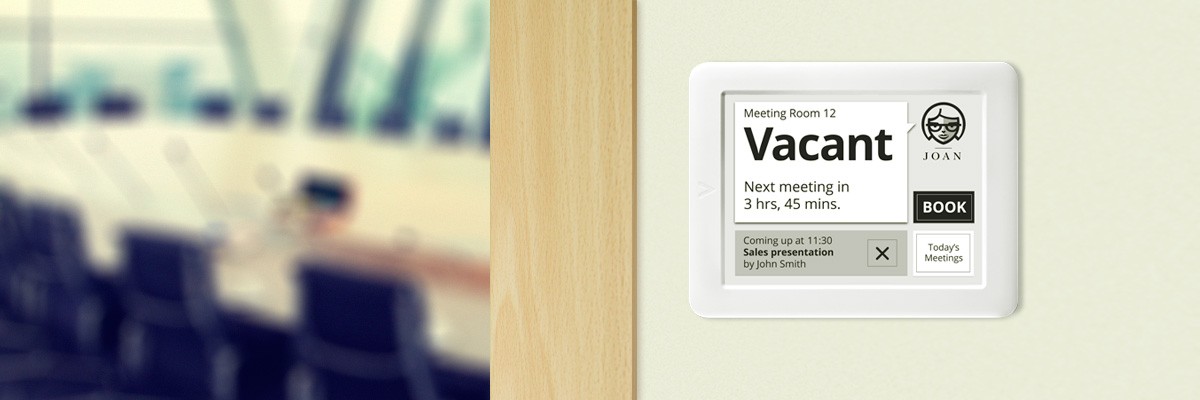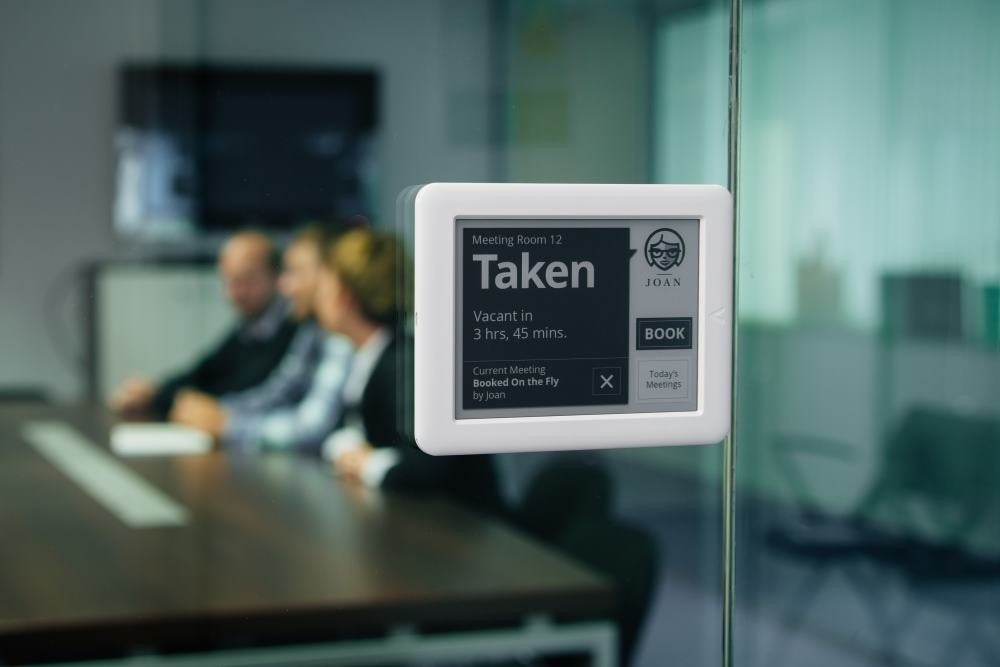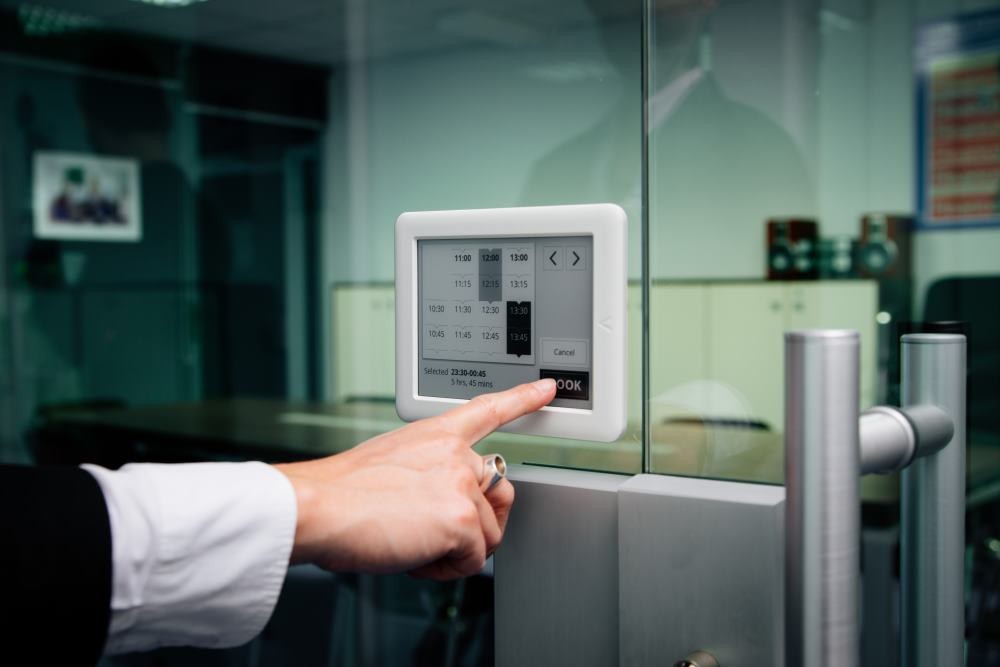

Trends in facility management: a need for an adaptable, long-lasting door labeling sign
Visionect, 11 May 2015
Facility management of today is going modern by going digital. In door labeling signs especially, there is a variety of different products available on the market – but what exactly are users looking for? We investigate the trends in facility management to find out what is most important to proprietors when it comes to digital meeting room labels.
Electronic signs in all shapes and forms are taking over buildings, rooms and halls: from smart interactive floor plans that provide detailed wayfinding information, to connected e-kiosks, billboards and tablets showing all the details of visiting a location, facility management of today is embracing the Internet of Things by going digital.
And in meeting room labeling this revolution has been more than necessary, with even the most technologically advanced companies having to resort to printing out paper room schedules and attaching them to the doors of their campus.
Now the market boosts a wide array of digital door signage products available, with solutions ranging from LCD screens, to Ethernet-connected displays and mounted Android tablets, to everything in between. But in an influx of digital door labels what exactly is it that conference hall or meeting room proprietors are looking for in a room sign?
Suitable for every surface
To start, the choice of labelling display is closely tied to one of the simpler, yet most basic questions of using an electronic door sign: on what surface do users want to mount it?
And while in the past this answer might have univocally been brick, plaster or another type of wall, the advent of modern, bright and open offices with unorthodox floor plans and versatile building materials has made installation surfaces somewhat more diverse. And with this diversity comes a need for a product that will adapt to it – which may prove somewhat tricky.

The installation of a digital door label is made even more difficult if the door label is actually mounted on the door itself or another type of material. Case in point: glass, the installation surface of choice for almost half of door sign users.
THE ELEGANCE OF WIRELESS
Even with traditional concrete surfaces the installation of a wired door label can be difficult if equipping a venue without wanting to undergo a major office renovation; it will be made even more difficult, however, if the door label is actually mounted on the door itself or another non-traditional material. Case in point: glass, the installation surface of choice for almost half of door label users.
In every office and across large campuses especially, a door labeling sign’s power economy is something that will most definitely play a role in selecting a door label.
While there exist options, albeit costly, of hammering away to aesthetically mount a cabled room booking screen on a brick wall of an office or meeting room lobby, there exist no such options when it comes to glass, wood (another popular choice), or another similarly challenging surface.
To seamlessly fit into just about any kind of office or venue, people are turning away from brackets, screws and bolts, and choosing light, wire-free door signs that run on an independent power source and fit just about anywhere, not requiring heavy drilling or ingenuity to mount (think velcro strips).
Long battery life, happy user
Which leads to the next dilemma of door signage: in a cordless room labelling solution that hits the mark in just about any installation scenario, the question of device battery life is an important piece of the puzzle.
In fact, it is almost a deal breaking one. With almost half of the users’ expectations of battery autonomy settling at around a couple of weeks’ mark, an independently-powered room booking solution would have to be able to successfully sustain the heavy traffic of office or conference hall use, featuring excellent battery autonomy.
In the brightly-lit LCD screens of the past, power efficiency might have proven difficult to attain; in fact, there are still door labeling solutions out there that leave much to be desired in terms of battery lifetime.
The development of new, energy-efficient technologies (such as e-ink, using power only when the image on the display is changing) coupled with the advent of green, sustainable offices, however, has given birth to door labelling solutions that know a happy user is one that will be able to use the door sign battery for a long time. In every office and across large campuses especially, a door labelling sign’s power economy is something that most definitely plays a role in selecting a door sign, adding up in favour of the building operator.
Instant booking? Yes! List of meetings? Sure, why not.
And then, of course, is the all important question of the product’s user interface and the functionality it allows in handling room booking.
A significant feature that is a must with users is the ability to book or cancel a meeting right on the spot, on the display itself. Instant booking at the meeting room door, without the aid of a phone or computer, is vital to nine out of ten door label users deciding on a room signage product. And while the functionality is more than welcome, it can also mean straining the available device power even further. In door signs running on an independent power source this again means choosing a solution that will be extremely power efficient.

The market wants a solution that provides booking right at the meeting room door, with a list of upcoming meetings clearly shown on the display itself.
A significant feature that nine out of ten users want is the ability to book or cancel a meeting right on the spot, on the display itself; in door signs running on an independent power source this means choosing a solution that will be extremely power efficient.
Another welcome feature in selecting a door label is its compatibility with the tools and programmes that the users are already using, such as different online calendars. This, however, does not mean that people want to have to use these tools to decipher what events are coming up where.
In fact, two thirds of door label users turn to signs that allow for transparency of bookings and show a list of meetings coming up directly at the device. In short: they are choosing solutions that are easy to use and require no additional devices to relay the existing availabilities of the space to be reserved.
Server hosting: yes or no?
In contrast to other preference for plug & play solutions, a surprising three quarters of door label users want to host the sign software themselves, using their own infrastructure, and don’t wish for the software supporting the door labels to be hosted elsewhere.
Users want a solution that is easy to use right of the bat, and requires no additional devices to communicate the details of the existing availabilities of the space to be reserved.
Such agreement on software independence can probably be attributed to the fact that room booking software had traditionally been a complex affair, one that before the advent of the Cloud required on-site servers and a hands-on approach to the system. And while the continued desire to take complete control over a meeting room booking sign is understandable, if not strictly necessary, users that are perhaps not as tech-savvy and want support in implementing the signs cannot be left behind.
To please both types of a signage user, the seasoned developer in a tech company and the office manager without advanced technical knowledge, the ideal door signage product would have to feature software that is both compatible with the users’ existing meeting scheduling software which can run on client’s proprietary infrastructure or in the cloud.
The best of all worlds scenario
No matter the industry, geographical location or company size, it is clear that trends in facility management demand that digital door labels
- adapt to every surface, with easy mounting on glass and other materials,
- have a long battery life,
- allow instant booking and lists the events scheduled, and
- enable flexible software hosting that adapts to the requirements of the user.
Tags

